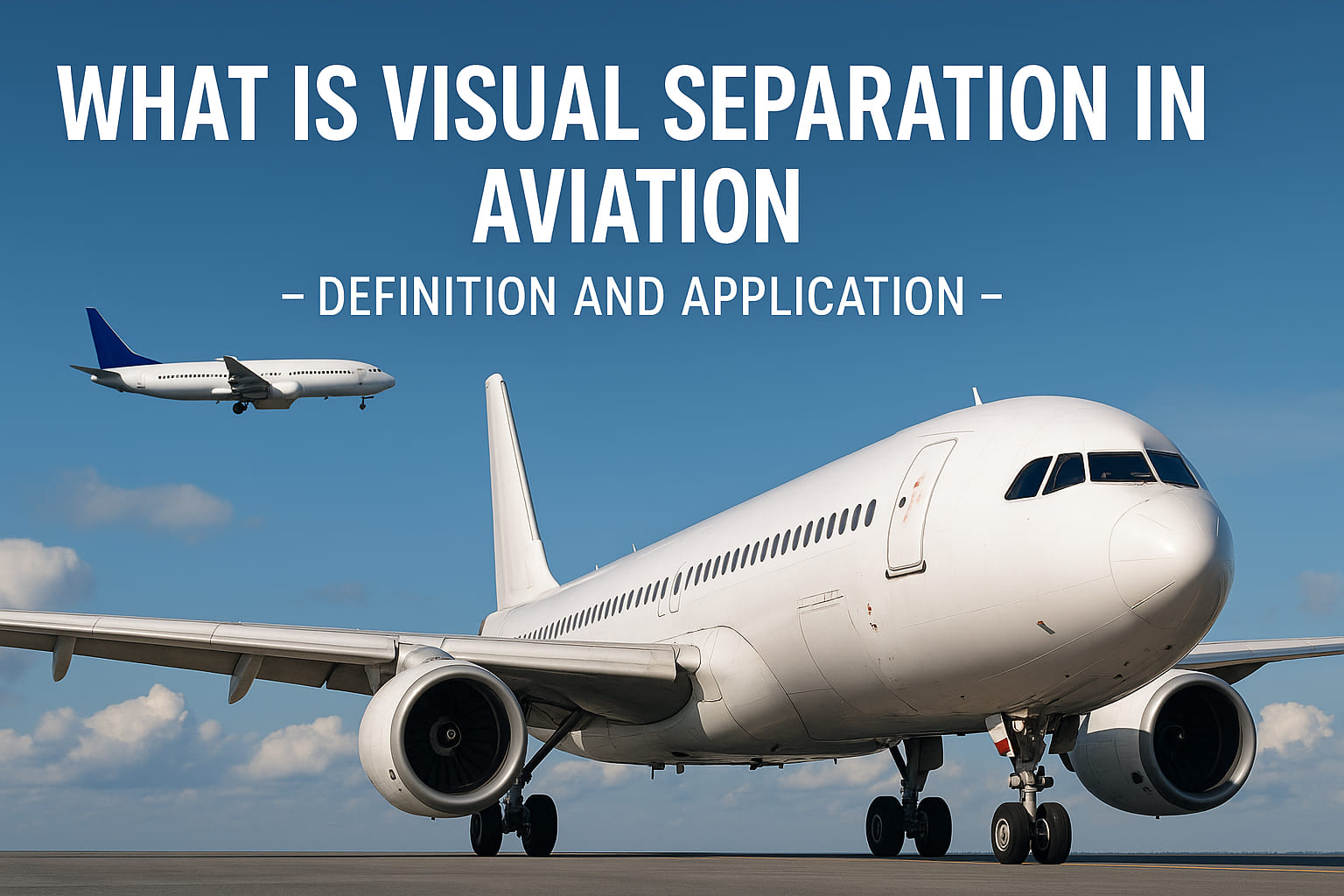In clear skies, air traffic controllers can rely on a pilot’s eyes instead of just radar. This is the core of visual separation, a procedure that shifts the duty of collision avoidance directly to the flight deck. So, what are the key rules governing this procedure and the exact responsibilities of the pilot?
👉 Check out the offer: airship engine stand for lease 👈
Understanding Visual Separation in Aviation
Visual separation is an Air Traffic Control (ATC) procedure that replaces standard radar or procedural minima with a simple, powerful tool: the human eye. It allows either a controller or a pilot to maintain safe spacing between aircraft through direct visual observation. While highly efficient, especially in busy terminal areas, its effectiveness hinges on two critical factors:clear weather and precise communication.
There are two primary ways visual separation is applied:
- Controller-Applied: When a tower controller has a clear view of both aircraft, they can direct each pilot with specific instructions and maneuvers to maintain separation. In this case, the responsibility is the controller’s responsibility.
- Pilot-Applied: Alternatively, a controller can instruct a pilot with the other aircraft in sight to take over and maintain their own separation. Upon the pilot’s acceptance, the responsibility for avoiding both collision and wake turbulence transfers to the pilot.
The process is formally initiated with an ATC traffic advisory. Once the pilot reports the traffic in sight, the controller gives the key instruction: “maintain visual separation.” The procedure becomes official only upon the pilot’s acknowledgment, a confirmation that they now assume full responsibility for staying clear.
Key Procedures for Visual Separation
The pilot’s core duty is to maintain continuous visual contact with the other aircraft.
Constant communication with Air Traffic Control is essential. Should the pilot lose sight of the other aircraft for any reason—be it cloud cover, sun glare, or unexpected maneuvers—they must notify ATC immediately. This single report is critical: it instantly terminates the visual separation procedure, requiring the controller to re-establish safety using another standard, like radar.
Finally, the use of this procedure depends on specific conditions. It’s primarily applied in terminal and en route airspace, but only when weather allows for uninterrupted visual contact. A key prohibition exists: visual separation is never authorized when following a “super” class aircraft, such as an Airbus A380, because of the immense wake turbulence they produce.
Pilot Responsibilities During Visual Separation
Accepting a visual separation instruction is a formal transfer of duty: the pilot now bears the primary responsibility for preventing a collision with the designated aircraft.
This duty extends beyond simple collision avoidance to include the danger of wake turbulence. The pilot is now tasked with actively managing their flight path to steer clear of the powerful vortices generated by the preceding aircraft—which demands constant situational awareness.
Avoiding Wake Turbulence in Visual Separation
Avoiding wake turbulence is a critical component of visual separation. When pilots accept this responsibility, they are not just tracking another aircraft; they are actively navigating away from its powerful wing tip vortices—a task requiring a proactive flight strategy.
The danger of wake turbulence is so significant that regulations explicitly forbid visual separation behind ‘super’ category aircraft like the Airbus A380. The vortices from these massive jets are not only exceptionally powerful but can also linger for several minutes, posing an invisible threat that sight alone cannot mitigate. This prohibition highlights that visual contact alone is not always sufficient to ensure safety.
To manage this risk, pilots must anticipate that vortices sink and drift with the wind, following standard procedures:
- During a landing approach, fly a slightly higher glide path and touch down beyond the other aircraft’s touchdown point.
- On departure, lift off before the preceding aircraft’s rotation point and climb on a trajectory that stays above its path.
The Role of Air Traffic Control in Visual Separation
Air Traffic Control (ATC) oversees visual separation, responsible for initiating or approving the procedure under specific conditions. From the tower, controllers can apply it directly if they have both aircraft in sight, issuing instructions to keep them clear. More commonly, however, they authorize it after a pilot reports seeing the conflicting traffic and confirms they can maneuver to maintain separation.
The entire process depends on a clear communication loop. It typically starts with an ATC traffic advisory, followed by the pilot’s crucial report: “traffic in sight.” The controller then issues the formal instruction, and the pilot’s acknowledgment—often just their call sign—confirms the agreement. Pilots can also proactively request it, as in the exchange, “PAT 25, has the traffic in sight, request visual separation,” signaling their readiness to assume control.
Visual separation is not a universal solution; its application is highly context-dependent. Around busy airports, in the terminal area, it is valuable for sequencing aircraft for approach and departure. In en route airspace, its use is more restricted, typically reserved for aircraft on opposite courses where one pilot has the other in sight. In either environment, the controller must ensure that a standard separation method like radar is in place both before the procedure begins and after it ends.
Authorizing visual separation is a formal transfer of responsibility. The moment a pilot accepts the instruction, the legal duty for avoiding collision and wake turbulence shifts to the pilot. While ATC continues to monitor the flight, a single report of “lost contact” instantly returns that responsibility to the controller, who must immediately implement an alternative separation standard.
Traffic Advisories and Visual Separation
The visual separation process begins with a traffic advisory from ATC. This provides the pilot with essential data to locate the other aircraft, including:
- Its position relative to them (e.g., “traffic, 2 o’clock”)
- Direction of flight
- Aircraft type
- Altitude
While controllers issue these advisories for any potential conflict, they become especially critical for aircraft on converging courses or when a smaller plane is trailing a larger one, where wake turbulence is a significant threat.
The pilot’s acknowledgment of “traffic in sight” is the critical step that allows the procedure to begin, signaling positive identification and marking the pilot’s transition to actively managing their own separation.
Regulations Governing Visual Separation
Visual separation is not an informal shortcut, but a formal procedure governed by strict regulations, outlined in the U.S. by FAA Order JO 7110.65. This key document for air traffic control requires that another approved separation method, like radar, must be in place both before and after its use. This requirement provides a safety net, ensuring a fallback is always available if visual contact is lost.
Several critical conditions govern the procedure. The weather must be clear enough for the pilot to maintain sight until another form of separation is guaranteed. Furthermore, specific prohibitions exist to reduce known dangers. For instance, the procedure is forbidden when following a “super” category aircraft like an Airbus A380, whose severe and persistent wake turbulence poses an unacceptable risk. This rule underscores a key principle: safety always overrides operational efficiency.
Effective Visual Scanning Techniques
Effective visual scanning is more than just looking out the window; it’s a disciplined skill essential for visual separation. The technique requires methodically sweeping the sky in short, overlapping segments, using central vision to spot distant aircraft and peripheral vision to catch movement. This constant, active scan is what allows a pilot to not only keep the other aircraft in sight but also to anticipate its next move.

